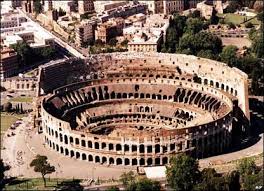THE COLOSSEUM
The Roman Colosseum

Construction of the Colosseum began by Emperor Vespasian in 72 AD. When Emperor Vespasian died in AD 79, the role of finishing the Colosseum was left in the hands of Vespasian's son, Titus. The Colosseum was made for entertainment for the king and people of Rome by making gladiators and Christians fight against a range of wild animals, as well as each other. The Colosseum was also used for mock naval battles which was when the Romans flooded the Colosseum with a large body of water and made gladiators fight on small ships.
The Colosseum was built as the central feature of an entertainment and commercial quarter in Ancient Rome. Whilst the Colosseum itself hosted large events the surrounding area was used by other entertainers and traders. With a large numbers of people attending events and with a large number of traders and entertainers the site would have been an extremely busy and exciting location to visit. The Colosseum was constructed in Rome which at the time was the center and capital city of a large empire. The Colosseum was a large amphitheater built for hosting large entertainment events. It was a large multi-storey circular built with stone and wood and capable of seating 50,000 spectators.
One of the three main features of the colosseum is the circular architecture. Another main feature is the 50,000 seats for spectators to watch the gladiator battles. The last main feature of the colosseum is the mechanical machines used for pulling up the doors of the cages to let the animals out.
One of the things that historians has learnt from this ancient site is that the Romans had highly developed architecture of the Colosseum. Another thing that historians have learnt about the Romans is that they enjoyed large spectacular entertainment events which were hosted in the colosseum.
Bibliography :
Website: A view on cities. (2012) available URL http://www.aviewoncities.com/_cityindex.htm last accessed May 27th 2012.
Book:
Banks, J.A (et al). (1995). The world past and present east and west. New York: Macmillan/McGraw-Hill school publishing company.
Construction of the Colosseum began by Emperor Vespasian in 72 AD. When Emperor Vespasian died in AD 79, the role of finishing the Colosseum was left in the hands of Vespasian's son, Titus. The Colosseum was made for entertainment for the king and people of Rome by making gladiators and Christians fight against a range of wild animals, as well as each other. The Colosseum was also used for mock naval battles which was when the Romans flooded the Colosseum with a large body of water and made gladiators fight on small ships.
The Colosseum was built as the central feature of an entertainment and commercial quarter in Ancient Rome. Whilst the Colosseum itself hosted large events the surrounding area was used by other entertainers and traders. With a large numbers of people attending events and with a large number of traders and entertainers the site would have been an extremely busy and exciting location to visit. The Colosseum was constructed in Rome which at the time was the center and capital city of a large empire. The Colosseum was a large amphitheater built for hosting large entertainment events. It was a large multi-storey circular built with stone and wood and capable of seating 50,000 spectators.
One of the three main features of the colosseum is the circular architecture. Another main feature is the 50,000 seats for spectators to watch the gladiator battles. The last main feature of the colosseum is the mechanical machines used for pulling up the doors of the cages to let the animals out.
One of the things that historians has learnt from this ancient site is that the Romans had highly developed architecture of the Colosseum. Another thing that historians have learnt about the Romans is that they enjoyed large spectacular entertainment events which were hosted in the colosseum.
Bibliography :
Website: A view on cities. (2012) available URL http://www.aviewoncities.com/_cityindex.htm last accessed May 27th 2012.
Book:
Banks, J.A (et al). (1995). The world past and present east and west. New York: Macmillan/McGraw-Hill school publishing company.
No comments:
Post a Comment